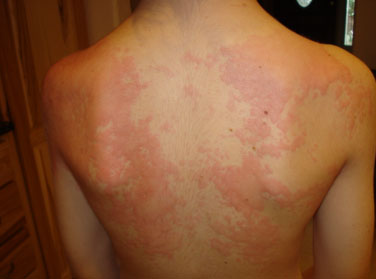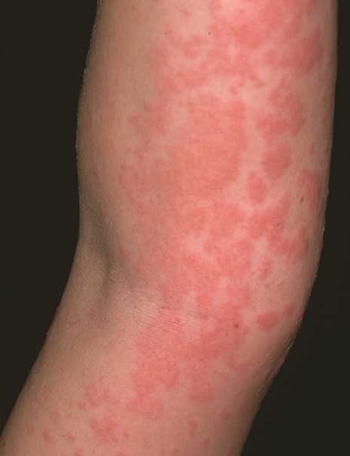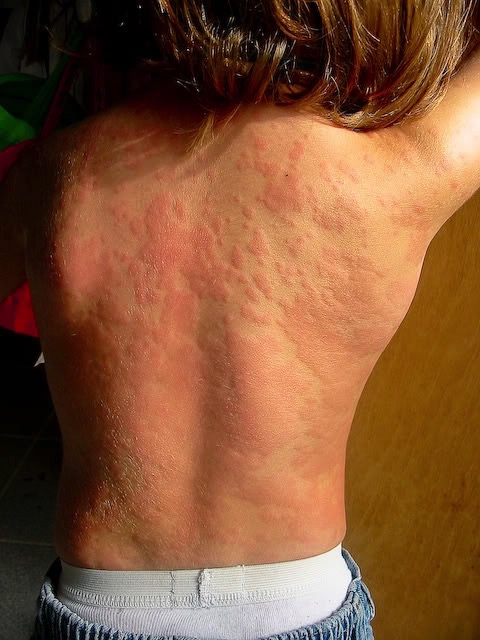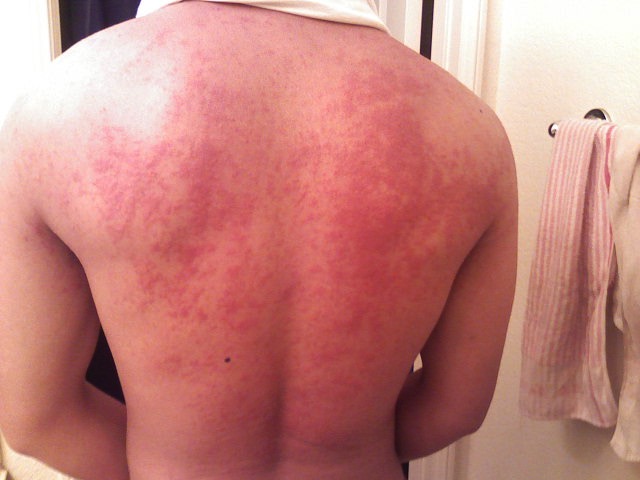Contact Us
HIVES (Urticaria and Angioedema)
Urticaria, also known as hives, is an outbreak of swollen, pale red bumps or plaques on the skin that appear suddenly -- either as a result of thebody's adverse reaction to certain allergens, or for unknown reasons.
Hives usually cause itching, but may also burn or sting. They can appear anywhere on the body, including the face, lips, tongue, throat, or ears. Hives vary in size (from a pencil eraser to a dinner plate), and may join together to form larger areas known as plaques. They can last for hours, or up to one day before fading.Angioedema is similar to urticaria, but the swelling occurs beneath the skin instead of on the surface. Angioedema is characterized by deep swelling around the eyes and lips and sometimes of the genitals, hands, and feet. It generally lasts longer than urticaria, but the swelling usually goes away in less than 24 hours. Rarely, angioedema of the throat, tongue, or lungs can block the airways, causing difficulty breathing. This may become life threatening.
What Causes Hives and Angioedema?
Hives and angioedema form when, in response to histamine, blood plasma leaks out of small blood vessels in the skin. Histamine is a chemical released from specialized cells along the skin's blood vessels.
Allergic reactions, chemicals in foods, insect stings, sunlight exposure, or medicines can all cause histamine release. Sometimes it's impossible to find out exactly why hives have formed.
There are several different types of hives, including:
Acute urticaria: Hives lasting less than six weeks.
Chronic urticaria and angioedema: Hives lasting more than six weeks.
Physical urticaria: Hives caused by direct physical stimulation of the skin - for example, cold, heat, sun, vibration, pressure, sweating, and exercise.
Dermatographism: Hives that form after firmly stroking or scratching the skin.
How Are Hives and Angioedema Diagnosed?
Your doctor will need to ask many questions in an attempt to find the possible cause. Since there are no specific tests for hives -- or the associated swelling of angioedema -- testing will depend on your medical history and a thorough examination by your primary care doctor or dermatologist. Skin tests may be performed to determine the substance that you are allergic to. Routine blood tests are done to determine if a system-wide illness is present.
How Are Hives and Angioedema Treated?
The best treatment for hives and associated swelling is to identify and remove the trigger, but this is not an easy task. Antihistamines can be prescribed by one of our specialist at Balfour Dermatology to provide relief from symptoms. Antihistamines work best if taken on a regular schedule to prevent hives from forming in the first place. Chronic hives may be treated with antihistamines or a combination of medications. When antihistamines don't provide relief, oral corticosteroids may be prescribed. For severe hive or angioedema outbreaks, an injection of epinephrine (adrenaline) or a cortisone medication may be needed.
How Can Hives Be Managed?
While you're waiting for the hives and swelling to disappear, here are some tips:
• Apply cool compresses or wet cloths to the affected areas
• Try to work and sleep in a cool room
• Wear loose-fitting lightweight clothes.
When Should I Call the Doctor?
If hives or angioedema occur with any of the following symptoms, contact Balfour Dermatology right away:
• Dizziness
• Tightness in the chest
• Wheezing
• Swelling of the tongue, lips, or face
• Difficulty breathing





